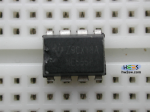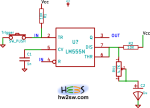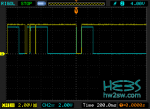
What remains of monostable configuration is the retriggerable mode.
To be concise, the retriggerable version simply gives you the possibility to extend the period of the ON time, that we saw in the previous post fixed by the external components; this is done just by giving a new trigger input while the output is still HIGH.
What happens?
From that input instant a new period starts, and if no other triggering inputs occur, the output signal will continue to stay high for that fixed period of time more.
Because we talked about the necessity to have an input impulse with a duration far quicker than the output one, we assume it as a rule.
Now we must concentrate on the core of the discussion: how to get the signal retriggered.
In other words where we must act to get success.
The key is simple, and it refers again to the combination of Set and Reset latch values changing.
We ended the previous post by noting how the NE555 can be non-retriggerable.
The input trigger where ignored until the cap didn't reach the voltage of 2/3 Vcc at its top; this set the R to 1, which electrically closed the discharging bjt, giving the cap the possibility to discharge.
Just below the 2/3 Vcc, the R turned back to 0, making the timer ready for a new valid trigger impulse.
BUT... we had to expect the entire cycle to complete, in order to get a new one: no way to renew it.
Well... the solution wants the cap to be discharged.
And contextually the valid trigger input must be furnished, so that there's no discontinuity to the the high output signal.
To give an idea, by continuously giving trigger inputs to the timer the output signal would remain high forever; this exaggeration wants only make you think to the limit condition.
Generally speaking, every time you give a right input then the period time of ON time is renewed until the inputs stop, making the cap charge to 2/3 Vcc and the relaxing, when possible, by releasing the charges.
Now the behavior is clear, so that we just need to fix some aspects; and the best way to do it is taking a look at few configurations, they will clarify that we have at least to methods to discharge the capacitor.

The very first type, and the simplest one, shorts the pins 2 and 4 so that for a low signal we have the global reset (which stops completely the timer's activity); with the reset removed automatically pin 4 goes high through the pull-up resistor, and same for the pin 2: but in the instant of releasing it's still low quite enough to give the latch the time to capture the trigger input impulse.
The only inconvenient is that if you keep the low signal for a "long" time then the output will go down instead of continuing to stay high.

Look at the picture beside: in the center you'll see the azure line (the output) going up and down quickly; that's because of playing with switch, the pressure has been kept an instant more than the necessary.
Where the pressure has been fast enough, you can see the output high for an amount of period greater than the one fixed by external components.